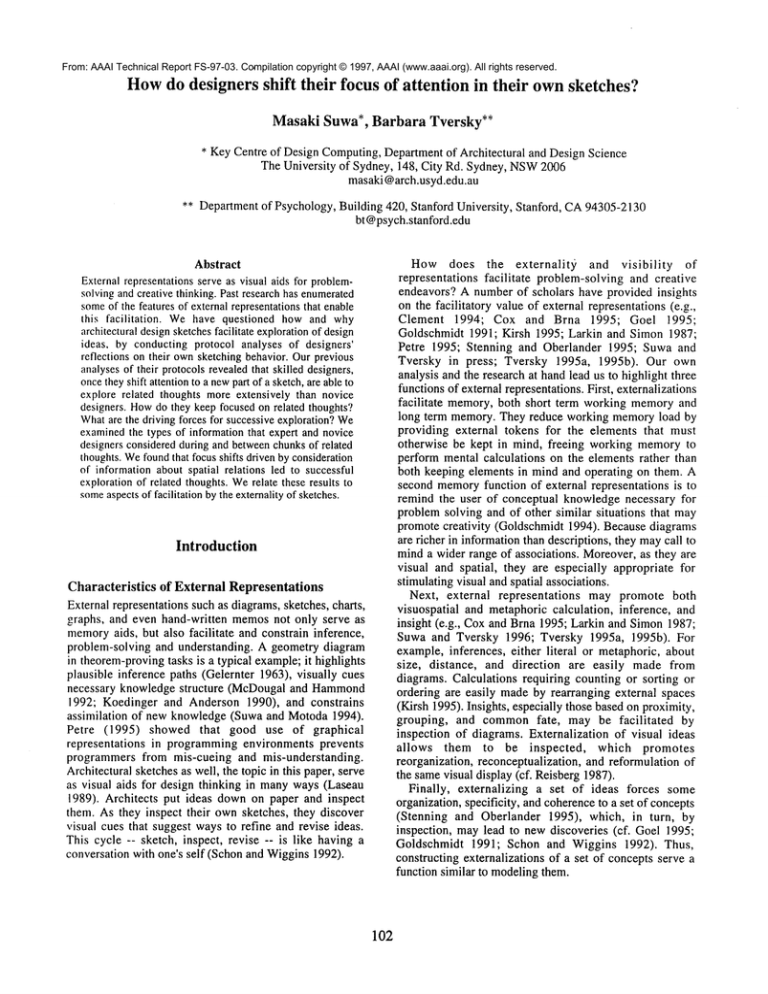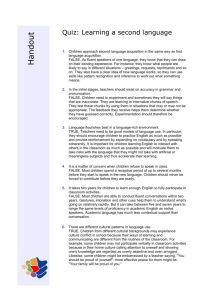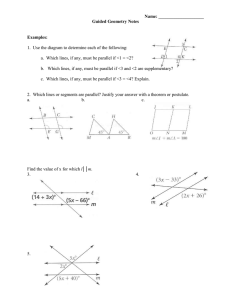
From: AAAI Technical Report FS-97-03. Compilation copyright © 1997, AAAI (www.aaai.org). All rights reserved.
Howdo designers shift their focus of attention in their ownsketches?
Masaki
Suwa*,
Barbara
Tversky**
* Key Centre of Design Computing,Departmentof Architectural and Design Science
The University of Sydney, 148, City Rd. Sydney, NSW
2006
masaki @arch.usyd.edu.au
** Departmentof Psychology, Building 420, Stanford University, Stanford, CA94305-2130
bt @psych.stanford.edu
Abstract
Externalrepresentationsserve as visual aids for problemsolving and creative thinking. Past researchhas enumerated
someof the features of externalrepresentationsthat enable
this facilitation.
Wehave questioned how and why
architecturaldesignsketchesfacilitate explorationof design
ideas, by conducting protocol analyses of designers’
reflections on their ownsketchingbehavior. Ourprevious
analysesof their protocolsrevealedthat skilled designers,
oncetheyshift attentionto a newpart of a sketch,are able to
explore related thoughts more extensively than novice
designers. Howdo they keep focusedon related thoughts?
Whatare the driving forces for successiveexploration?We
examinedthe types of informationthat expert and novice
designers consideredduring and betweenchunksof related
thoughts.Wefoundthat focus shifts driven by consideration
of informationabout spatial relations led to successful
explorationof related thoughts.Werelate these results to
someaspectsof facilitation bythe externalityof sketches.
Introduction
Characteristics of External Representations
External representations such as diagrams, sketches, charts,
graphs, and even hand-written memosnot only serve as
memoryaids, but also facilitate and constrain inference,
problem-solving and understanding. A geometry diagram
in theorem-provingtasks is a typical example;it highlights
plausible inference paths (Gelernter 1963), visually cues
necessary knowledge structure (McDougaland Hammond
1992; Koedinger and Anderson 1990), and constrains
assimilation of new knowledge (Suwa and Motoda 1994).
Petre (1995) showed that good use of graphical
representations in programming environments prevents
programmers from mis-cueing and mis-understanding.
Architectural sketchesas well, the topic in this paper, serve
as visual aids for design thinking in manyways (Laseau
1989). Architects put ideas downon paper and inspect
them. As they inspect their ownsketches, they discover
visual cues that suggest ways to refine and revise ideas.
This cycle -- sketch, inspect, revise -- is like having a
conversation with one’s self (Schon and Wiggins1992).
102
How does the externalit3~
and visibility
of
representations facilitate problem-solving and creative
endeavors? A number of scholars have provided insights
on the facilitatory value of external representations (e.g.,
Clement 1994; Cox and Brna 1995; Goel 1995;
Goldschmidt 1991; Kirsh 1995; Larkin and Simon 1987;
Petre 1995; Stenning and Oberlander 1995; Suwa and
Tversky in press; Tversky 1995a, 1995b). Our own
analysis and the research at hand lead us to highlight three
functions of external representations. First, externalizations
facilitate
memory,both short term working memoryand
long term memory. They reduce working memoryload by
providing external tokens for the elements that must
otherwise be kept in mind, freeing working memoryto
perform mental calculations on the elements rather than
both keeping elements in mind and operating on them. A
second memoryfunction of external representations is to
remind the user of conceptual knowledge necessary for
problem solving and of other similar situations that may
promote creativity (Goldschmidt 1994). Because diagrams
are richer in informationthan descriptions, they maycall to
mind a wider range of associations. Moreover, as they are
visual and spatial, they are especially appropriate for
stimulating visual and spatial associations.
Next, external representations
may promote both
visuospatial and metaphoric calculation, inference, and
insight (e.g., Cox and Brna 1995; Larkin and Simon1987;
Suwa and Tversky 1996; Tversky 1995a, 1995b). For
example, inferences, either literal or metaphoric, about
size, distance, and direction are easily made from
diagrams. Calculations requiring counting or sorting or
ordering are easily made by rearranging external spaces
(Kirsh 1995). Insights, especially those based on proximity,
grouping, and commonfate, may be facilitated
by
inspection of diagrams. Externalization of visual ideas
allows them to be inspected,
which promotes
reorganization, reconceptualization, and reformulation of
the samevisual display (cf. Reisberg 1987).
Finally, externalizing a set of ideas forces some
organization, specificity, and coherenceto a set of concepts
(Stenning and Oberlander 1995), which, in turn,
inspection, maylead to new discoveries (cf. Goel 1995;
Goldschmidt 1991; Schon and Wiggins 1992). Thus,
constructing externalizations of a set of concepts serve a
function similar to modelingthem.
There are a numberof advantages to studying the use of
external representations in real-world domainswhere the
external representations are produced by problem-solvers
and inherent in the problem-solving. The domainwe have
chosen is that of architectural design. There is some
similarity even across cultures in the waysthat architects
use sketches in designing. Their early sketches, those that
are useful in solving the most elemental and essential
problems, differ greatly from the architectural plans and
models presented to the public (Fraser and Henmi1994;
Laseau 1989; Landay and Myers 1995; Robbins 1994).
First, they are sketchy. That is, they are not at all specific.
Rather, they tend to use blobs with indeterminate shape to
indicate possible spatial arrangements.Next, they are twodimensional, typically beginning with a plan or overview,a
horizontal view. Only after determining the spatial
arrangement do architects turn to the vertical plane. As
Arnheim(1977) noted, the horizontal plane of architectural
drawings defines the plane of function; it shows how
people will interact with the environment. The vertical
plane is the plane of appearance; it shows how the
environmentwill look to observers.
Wehave been studying the early stages of the design
process by presenting a problem, the design of an art
museum,to practicing architects and to architectural
students. After workingon the design, participants viewed
videos of their design sessions and reported what they were
thinking as they drew. Wehave been analyzing those
protocols (Suwaand Tversky, in press), and we will report
further analyses here. Design sketches are a particularly
interesting domainto study as they serve a dual purpose to
the designer: they are used to express and demonstrate
design ideas and they serve as a graphic display to be
inspectedto critique, to refine, and to generatefurther ideas
(Goldschmidt 1994).
a set of contiguously occurring segments that are
conceptually related to each other a "dependencychunk".
See (Suwaand Tverskyin press) for the precise definition
of "dependencychunk". The basic idea is that if a segment
"A" is not related to any segments in the conceptually
related sequence that immediately precedes the segment A,
then the set of previous segments are grouped into a
dependency chunk, and the segment "A" is treated as a
focus-shift.
The entire design process consists of manydependency
chunks(see Fig. 1). Somechunksconsist of relatively many
segments and others a few. In extreme cases, chunks
consist of only one segment. Wecall it an "isolated"
segment. In such cases, a designer shifted attention to a
newtopic, but failed to explore any related thoughts, and
then shifted to another.
[] focus-shift segments
r--’l continuingsegments
Mdependencylinks
O dependenc), chunks
Fig. 1: A schematicdiagramof segments,conceptualdependency
and dependencychunks
Segments are classified into two types, as shown in
Fig.1. One is the first segment in each dependencychunk.
It represents a topic to whichthe designer’s attention has
been newlyshifted. Wecall it a "focus-shift" segment. The
remaining segments that follow a focus-shift segment are
called "continuing" segments.
Wefound evidence that skilled designers had more and
longer dependency chunks than novices (Suwa and
Tversky1996; in press). Onceexperts shift their focus to
new topic, they are more capable of exploring related
thoughts. Forminglonger chunks leads to deeper and more
substantial exploration, and thus contributes to the success
of a design process.
Review of the Previous Findings on Design
Processes
Our previous research had two main results. The first was
to classify the types of information that participants
perceive and report thinking about as they sketched (Suwa
and Tversky1996; in press). The information fell into three
majorcategories; emergentproperties, spatial relations and
functional thoughts, each with subcategories to be
discussed. Importantly, emergent properties and spatial
relations are visual in nature, whereasfunctional thoughts
are inherently non-visual. Designers, especially expert
designers, read themoff fromthe visual display.
The second result was to identify the basic units and
structure of the design process. The design process
proceedsin cycles. First, designers turn their attention to a
new design topic from which they start to explore
conceptually related topics. Whenthat topic has been
exhausted, designers turn their attention to a newtopic. We
call each fragmentof design thought, whichis the smallest
unit of design processes, a "segment". A segment, whether
consisting of one sentence or many, is defined as one
coherent statement about a single item/space/topic. Wecall
The Goal of This Paper
One markof expertise in architectural drawings as well as
other skilled domains is larger chunks of knowledge
(Chase and Simon 1973). So, why and how are expert
architects
able to explore related thoughts more
successfully? Whatare the driving forces that allow them
to form longer dependency chunks? We address this
question, reducing it to two precise questions. First, what
kinds of focus-shifts are likely to prolong subsequent
related thoughts? Second, what types of within-chunk
thoughts are likely to prolong chunks of related thoughts?
To address these questions, we compared the types of
information that occurred in longer and shorter chunks.
103
that the designer himself feels from visual aspects of
sketches. Reactions denote the influence and impact that
visitors to the museumwould have from the design. The
last three subclasses are typical considerations in
architectural designs.
Experiment
The Architectural Design Task
The experimentconsisted of two tasks, a design task and a
report task. Five practicing architects and six architectural
students participated. In the design task, each participant
worked on designing an art museumthrough successive
sketches for 45 minutes. They were provided with a simple
diagramrepresenting an outline of the site, in which they
were supposed to arrange not only a museumbuilding but
also a sculpture garden, a pond, a green area, and a parking
lot. The building wasrequired to have entrance(s), a ticket
office(s), display rooms for about 100 paintings,
cafeteria, and a gift shop. Participants were told that the
curator wants this to be a museum
of "light, air and water".
They were supposed to use freehand sketches as a tool for
designing. Their sketching activity was videotaped.
Following the design task was the report task. While
watching their ownvideotapes, participants were asked to
rememberand report what they were thinking as they drew
each portion of each sketch. Participants were not
interrupted with questions during the report. Werecorded
the participants’ voices as well as videotaped the screen
itself on which not only their sketching activity in the
design task but also their pointing gestures in the report
task werevisible. Thecontent of their verbal report is used
for our analysis. Their pointing gestures helped clarify
what they were reporting on.
Information Subclasses
The contents of participants’
verbal protocols were
encoded into subclasses of major categories.
The
determination of the major categories, i.e. emergent
properties, spatial relations and functional thoughts, and
their subclasses was based on empirical and theoretical
considerations (see Suwaand Tversky, in press).
Emergentproperties denote depicted elements and their
visual features. The subclasses are spaces in a sketch,
physical entities, structural components,shapes, sizes, and
materials/textures.
Spatial relations denote spatial
arrangements amongtwo or more depicted elements. The
subclasses are horizontal spatial relations, vertical spatial
relations and horizontal global relations. The first two are
local in contrast to the third; they are relationships among
locally existing elements. Vertical relations primarily refer
to structural componentsthat are constructed on top of
others. Global relations include locational relationships
between the entire site and specific spaces on the site,
directions depicted elements face, and rough spatial
organizationof elementsin the site.
The subclasses of functional thoughts are practical roles,
abstract features, reactions of people, circulation of people
and cars, view issues, light issues. Practical roles denote
the roles that designed elements functionally play in a
museum.Abstract features denote sensations and emotions
Encoding of Verbal Protocols
For each participant, we divided the entire protocol into
segments. Then, by analyzing conceptual dependency
amongsegments, we identified the dependencychunks and
thereby the distinction betweenfocus-shift and continuing
segments. Further, for each segment, we encoded its
semantic content into information subclasses. Typically,
the protocol for a participant consisted of a few hundred
segments. The numberof encoded subclasses varied from a
few hundredto a thousand, dependingon the participant.
RESULTS
Length of Dependency Chunks: Architects vs.
Students
Wefirst wantedto reconfirm the difference in the length of
chunks between skillful designers and novices because we
added a number of practicing architects’ data to our
previous corpus. First, we calculated the average numberof
segments in a chunk (ANS) for each participant,
and
compared it between architects and students. The ANS
averaged over the five architects was 2.5 with a standard
deviation of 0.48, whereas the ANSaveraged over the six
students was 1.9 with a standard deviation of 0.18. A
statistically significant difference is recognized, t(9)=2.46
(p<0.025).
Then, for more precise confirmation, we examined to
what extent longer streams of related thoughts are
dominantin participants’ design process: we calculated the
ratio of the number of segments belonging to "long"
chunks1 to the total numberof segmentsin the protocol for
each participant. The advantageof using this ratio for more
precise analysis over the ANSvalue is that unlike the ANS
value the ratio is not affected by the configuration within
"shorter" chunks, that is, the distribution of the numberof
"isolated" segments and the number of chunks whose
length is 2. Table 1 showsthat the averageratio of the five
architects is statistically greater than that of the six
students,
t(9)=2.16 (p<0.05). Thus, one salient
characteristic distinguishing expert from novice designers
is longer streams of segmentsthat are conceptuallyrelated.
At the same time, we found that the students happen to
divide into two groups by chunk length, as shownin Table
1 Wedefined "long" chunks as those whoselength is equal
to or greater than 3 segments. This is justified by the
finding that the ANSvalue averaged over the architects,
whoproduced longer chunks than students, was 2.5.
104
I, t(4)=2.56 (p<0.05). The three students with higher ratios
actually fit within the range of lc~ around the average of
architects.
So, we added the three students with
significantly longer chunksto the sampleof five architects
to examine characteristics of long chunks. The remainder
of the analyses are on these eight "experts".
Table1: Theratio of the numberof segmentsbelongingto long
chunksto the total numberof segments
Architects
average (%) std
62.8
11.5
Students
average (%) std
48.9
8.4
Students 1-3
Students 4-6
average (%) std average (%) std
55.0
5.3
42.8
6.3
Information Categories: Focus-shift vs.
Continuing Segments
Shifting attention to a new topic and exploring thoughts
related to a current topic are different mentalactivities. We
examined the difference in terms of the types of
information that frequently occur in focus-shift and
continuing segments. For each participant, we counted the
number of information categories per ten segments, for
both kinds of segments. Figure 2 shows the average
frequency over the eight participants for both segmentsfor
each of the three major categories. Emergentproperties are
more frequent in focus-shift segments than in continuing
segments. Spatial relations are more frequent in continuing
segments.
2G ..............
15
FS. -- focus-shift segments
Cont.-- continuingsegments:
within subjects is feasible. Most of our analyses will be
based on the numbersof participants for whoma particular
pattern of data is significant.
Weexamined, for each participant for each information
subclass of each major category, whether or not the
information subclass occurs statistically
more or less
frequently in focus-shift segments than in continuing
segments. Table 2 shows, for each major category, the
numberof participants for whomat least one subclass of
the major category was more frequent in either type of
segment. For most participants, at least one subclass of
emergent properties was more frequent in focus-shift
segments,and at least one subclass of spatial relations in
continuing segments.
This result suggests an overall tendency that emergent
properties were more characteristic
of focus-shift
segments, and that spatial
relations
were more
characteristic of continuing segments.
Table2: Thenumberof participants, for eachmajorcategory,for
whom
at least one subclassof the categorywasmorefrequentin
either type of segment
emergent spatial
functional
properties relations thoughts
focus-shift >>continuing
7
2
2
continuin[~>>focus-shift
1
6
3
Information Categories in Long Chunks: Focusshift vs. Continuing Segments
Following this, we conducted the same analysis for tong
chunks only. Differences from the overall tendency may
suggest the necessary conditions for long chunks. Figure 3
shows, for each major category for both kinds of segments,
the average numberof pieces of information belonging to
the category per ten segments.
..... "~....... j FS. -- focus-shiftsegments
~~";
20t" i~’~i C°nt’-- c°ntinuing
segments:15
~ .......
FS. Cont. FS. Cont. FS. Cont.
emergent spatial
functional
properties relations thoughts
Fig. 2: Averagenumberof pieces of informationbelongingto the
categoryper ten segments,for eachmajorcategoryfor bothkinds
of segments.
FS. Cont. FS. Cont. FS. Cont.
emergent spatial
functional
properties relations thoughts
Fig. 3: Averagenumberofpieces of informationbelongingto the
categoryper ten segments,for eachmajorcategoryfor bothkinds
of segmentsin long chunks.
Then, we decided to analyze these phenomenain more
detail for each information subclass of each major category
within subjects. The reasons are as follows. First, the
type(s) of information subclass that each participant
frequently thought of in focus-shift or continuing segments
maydiffer from each other, and therefore investigations
across subjects may suppress individual differences.
Second,the numberof subjects is small, so it is difficult to
reach statistical
significance for the entire group of
subjects. However,the numberof information subclasses
per subject is large, so reaching statistical significance
For emergent properties, the same tendency as the overall
one is observed for long chunks as well: emergent
properties were more frequent in focus-shift segmentsthan
in continuing segments. For spatial relations, however,the
105
tendency is less salient for long chunks: spatial relations
were as frequent in continuing segments as in focus-shift
segments.
Then, we examined, for each participant for each
information subclass of each major category, whether or
not the information subclass occurs statistically more or
less frequently in the focus-shift segmentsof long chunks
than in the continuing segmentsof long chunks. Table 3 is
similar to Table 2, showingthe numberof participants, for
each major category, for whomat least one subclass of the
category was more frequent in either type of segment. For
most participants, at least one subclass of emergent
properties was important in the focus-shift segments of
long chunks as well. Comparingwith Table 3, however,
fewer participants (2 instead of 6) exhibited the tendency
that at least one subclass of spatial relations was more
frequent in the continuing segmentsof long chunks than in
the tbcus-shift segmentsof long chunks.
emergent properties was more frequent in the focus-shift
segmentsof long chunksis five, whereasthe corresponding
numberfor those of shorter chunks is three. This means
that, for someparticipants, thinking of certain subclasses of
emergent properties in focus-shift segments mayprolong
the subsequent related thoughts, but mayrather shorten
them for other participants. In contrast, for a greater
numberof participants, thinking of subclasses of spatial
relations is more associated with long chunks than with
shorter ones. For functional thoughts, the tendency is
mixed; thinking of subclasses of functional thoughts may
or maynot be more associated with long chunks than with
shorter chunks. To sum, it seems that thinking about
subclasses of spatial relations in focus-shift segmentsis
likely to lengthen the subsequentchunks.
Table4: Thenumber
of participants, for eachmajorcategory,for
whom
at least one subclassof the categorywasmorefrequentin
the focus-shiftsegments
of longchunksor in thoseof shorter
chunks
Table3: Thenumber
of participants, for eachmajorcategory,for
whom
at least one subclassof the categorywasmorefrequentin
either type of segmentof long chunks
emergent spatial
properties relations
focus-shift >>continuing
6
2
continuinLz
>>focus-shift
1
2
functional
thoughts
long >>shorter
shorter >>lon~
1
emergent spatial
functional
properties relations thou[~hts
5
5
5
3
1
2
Table 5 shows, for each participant, the subclasses that
he or she more frequently thought of in the focus-shift
segments of long chunks than in those of shorter chunks.
Importantly, the subclasses that each participant relied on
as a driving force for successive exploration differed from
each other, yet each participant relied on at least one
subclass of spatial relations or functional thoughts. Further,
morethan one participant relied on horizontal local spatial
relations, abstract features, or practical roles. This suggests
the significance of these subclasses in focus-shift segments
as a driving force of the subsequent exploration, but
significant subclasses maynot be limited to these because
of the small numberof participants.
The results may be summarized as follows. The overall
tendency that spatial relations are more frequent in
continuing segments than in focus-shift segments derives
not from long chunks but from shorter chunks. Further,
both types of segment in long chunks possess similar
characteristics in terms of the frequency of the subclasses
of spatial relations.
Information Categories in Focus-shift Segments:
Long Chunks vs. Shorter Chunks
These results motivated us to compare long chunks with
shorter chunks in terms of the frequency of information
subclasses. One comparison is between the focus-shift
segments of long chunks and those of shorter chunks.
Another is between the continuing segments of long
chunks and those of shorter chunks. As far as the latter
comparison is concerned, we found no significant
differences. This is consistent with the fact that, for all the
major categories, the density of pieces of information
belonging to each category in the continuing segments of
long chunks(shownin Fig.3) is almost the same as those
the continuing segments of the entire protocol (shown in
Fig.2). Here, the comparison between the focus-shift
segments of long chunks and those of shorter chunks is
reported.
Table 4 shows, for each major category, the number of
participants for whomat least one subclass of the category
was significantly morefrequent in the focus-shift segments
of long chunks or in those of shorter chunks. First, the
numberof participants for whomat least one subclass of
Table5: Theinformationsubclasses,for eachparticipant, that
werestatistically morefrequentin the focus-shiftsegments
of
longchunksthan in those of shorter chunks
participants
architect1
architect2
subclassesof subclasses
emergent
of spatial
relations
properties
vertical
structure
architect3
architect4
architect5
student1
student2
student3
106
global
structure
spaces
structure
shape
subclassesof
functional
thoughts
practicalroles,
lights
abstractfeatures
practicalroles,
circulation
horizontal
horizontal
views
horizontal abstract features
because those elements are organized in locations in a
sketch in a specific way, the discovery of implicit empty
spacesis facilitated.
Second, thinking about spatial relations, especially
horizontal local spatial relations, both in focus-shift
segments and during the very exploration of related
thoughts was found to be important. Generally speaking,
there are three possible cases in whicha participant thinks
of spatial relations in focus-shift segments.First, he or she
revisits a spatial relation that was considered before.
Second, he or she tries to create a new element in an empty
space, regarding the spatial relation betweenthe element
and other existing elements. Third, he or she newly
discovers an implicit, thus unintended, spatial relation
between more than two existing elements. Sketches
facilitate
these types of actions as well. A specific
organization of elementsin a sketch brings the participant’s
attention to previously attended relations, and even
facilitates the discovery of emptyspaces and newrelations.
Discussion
Expert Designers Have Longer Chunks
One salient difference betweenexpert and novice designers
is that experts’ protocols have longer sequencesof related
ideas. This suggests that designers are better able to use
sketches to develop more complex design thoughts. One
way to promoteexpertise, then, wouldbe to teach novices
to use sketches the wayexperts do. In order to do that, we
need to knowwhat type of thoughts dominatein focus-shift
and continuing segments, especially for longer chunks.
Emergent Properties in Focus-shift Segments
Witha sampleof 5 practicing architects and 3 architectural
students with especially long chunks,it is difficult to make
statistical
comparisons across subjects. Instead, we
examinedstatistically significant patterns within subjects,
and found some similarities suggestive of generalities
across subjects. First, it seemsthat thinking about emergent
properties was commonlyassociated with focus-shift more
than continuing segments. This tendency was salient also
when we observed only long chunks.
Function in External Representations
Whereas using external representations to facilitate
thinking about entities or elementsand their spatial array is
straightforward, thinking about functional aspects of the
situation from the external representation requires
associations and inferences from the visuospatial display to
things that are not purely visual or spatial. In the present
analysis, functional thoughts are not moreassociated with
any specific type of segment. However, our previous
analyses of the protocols (Suwa and Tversky in press)
showedthat experts are moreadept at perceiving functional
thoughts from external representations than novices. This
result is suggestive of an important role of external
representations. Visual aspects of external representations
facilitate associations, reminding and inferences that are
necessary for calling to mind non-visual aspects of design
thoughts.
Spatial Relations in Focus-shift Segments and
Continuing Segments
Second, thinking about spatial relations was commonly
associated with continuing more than focus-shift segments,
when we observe the overall tendency throughout the
entire protocol. This tendency, however, drives from
shorter chunks. Actually, in long chunks, spatial relations
were not more associated with either type of segment.
Investigating the comparison between the focus-shift
segments of long chunks and those of shorter chunks, we
found a tendency that spatial relations were more
associated with the focus-shift segments of long chunks
than with those of shorter chunks.Put differently, thinking
of spatial relations in focus-shift segmentsmayprolong the
subsequentrelated thoughts.
Conclusion
Weopened by discussing someof the benefits of external
representations in thinking and problem solving. As we
have shown in our detailed analyses of designers’
retrospective reports of their drawingactivity in design,
sketches serve most of these roles for architects in the
design process.
Sketches facilitate
memory by
externalizing the basic design elements, freeing the
designer to think about the emergent properties of the
elements, the spatial arrangements amongthem, and the
functional implications of the elements and their spatial
arrangement. Sketches promote calculations, inferences,
and insights by serving as a spatial display on which those
mental operations can be performed, and by promoting
mental operations based on spatial factors such as
proximity, grouping, distance, direction, common
fate, and
continuity. Finally, sketches facilitate design by inducing
Locations and Relations in External
Representations.
Howshould these findings be interpreted? Sequences of
related thoughts may be longer either because the
information in the focus-shift segment is especially
successful in stimulating related thoughts or because the
primary information used in the continuing segments is
useful for continuingrelated thoughts, or both.
First, thinking about emergent properties seemed to
stimulate shifting focus to a newtopic. Sketches facilitate
this type of action. Emergentproperties are visible in or
suggested by sketched elements. Simplybecause the tokens
tbr designed elements are externally represented and thus
visible, they becomethe target of focus shifts. Andsimply
107
designersto be explicit and specific to a certain degree, and
thereby to benefit from unintendeddiscoveries.
Laseau, P. 1989. Graphic Thinking for Architects and
Designers (second edition). Van Nostrand Reinhold, New
York.
Acknowledgments
Wewouldlike to express our thanks to J. P. Protzen and Y.
E. Kalay at University of California, Berkeley, his former
student, Jinwon Choi, and P. Teicholz at CIFE, Stanford
University, for putting us in contact with students of
architecture and practicing architects, and to the staff at the
Departmentof Architecture of U. C. Berkeley for lending
space and equipmentto us.
McDougal, T.; Hammond,K. 1992. A Recognition Model
of GeometryTheorem-Proving.In Proceedings of the 14th
annual conference of the cognitive science society, 106111. LEA,Inc. NJ.
Petre M. 1995. Why Looking isn’t Always Seeing:
Readership
Skills
and Graphical
Programming.
Communicationsof the ACM,38(6): 33-44.
Reisberg, D. 1987. External Representations and the
Advantages of Externalizing
One’s Thoughts. In
Proceedings of the 9th Annual Meeting of the Cognitive
Science Society. 281-293.
References
Arnheim, R. 1977. The dynanzics of architectural form.
University of California Press, Berkeley.
Robbins, E. 1994. WhyArchitects Draw. The MITPress,
Cambridge.
Chase, W. G.; Simon, H. A. 1973. Perception in Chess.
Cognitive Psychology, 4:55-81.
Schon, D. A.; Wiggins, G. 1992. Kinds of Seeing and
Their Functions in Designing. Design Studies, 13: 135-156.
Clement, J. 1994. Use of Physical Intuition and Imagistic
Simulation in Expert Problem Solving. In Implicit and
Explicit Knowledge(ed.) by D. Tirosh. Ablex Publishing
Company.
Stenning, K.; Oberlander, J. 1995. A Cognitive Theory of
Graphical and linguistic
Reasoning: Logic and
Implementation,Cognitive Science, 19: 97-140.
Cox. R.; Brna, P. 1995. Supporting the Use of External
Representations in Problem-Solving:the Needfor Flexible
Learning Environments. Journal of Artificial Intelligence
in Education, 6(2).
Suwa, M., Motoda, H. 1994. PCLEARN:A Model for
Learning Perceptual-Chunks. In Proceedings of the 16th
annual conference of the cognitive science socieO’, 830835. LEA,Inc., NJ.
Fraser, I. and Henmi,R. 1994. Envisioning Architecture:
an Analysis of Drawing. Van Nostrand Reinhold, New
York.
Gelernter, H. 1963. Realization of a Geometry-Theorem
Proving Machine. In Computerand thought (ed.) by E.A.
Feigenbaum & J. Feldman. MacGraw-Hill.
Goel. V. 1995. Sketches
Cambridge.
of Thought..
Larkin, J.; Simon, H. A. 1987. Why a Diagram is
(sometimes) Worth Ten Thousand Words. Cognitive
Science,1 t : 65-99.
MIT Press,
Suwa,M.; Tversky, B. 1996. WhatArchitects See in Their
Design Sketches: Implications for Design Tools. in Human
factors in computing systems: CHI’96 conference
companion, 191-192. ACM,NewYork.
Suwa, M.; Tversky, B. 1997. What Do Architects and
Students Perceive in Their Design Sketches?: A Protocol
Analysis. DesignStudies, forthcomingin 18(4).
Tversky, B. 1995a. Cognitive Origins of Graphic
Conventions. In Understanding images (ed.) by F
Marchese, 29-53. Springer-Verlag, NewYork.
Goldschmidt, G. 1991. The Dialectics of Sketching.
CreativiO’ ResearchJournal, 4(2): 123-143.
Goldschmidt, G. 1994. On Visual Design Thinking: the vis
kids of Architecture. DesignStudies 15(2): 158-174.
Tversky, B. 1995b. Perception and Cognition of 2D and 3D
Graphics. In Humanfactors in computing systems: CHI’95
conference companion, 175. ACM,NewYork.
Kirsh, D. 1995. The Intelligent Use of Space. Artificial
Intelligence. 73( 1-2):31-68.
Koedinger, K. R.; Anderson, J. R. 1990. Abstract Planning
and Perceptual Chunks: Elements of Expertise in
Geometry. Cognitive Science, 14:511-550.
Landay, J. A.; Myers, B. 1995. Interactive Sketching for
the Early Stages of User Interface Design. In Human
factors in Computing Systems: CHI’95 Conference
Proceedings, 43-50. ACM,NewYork,
108







